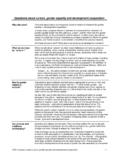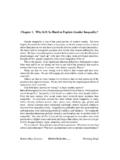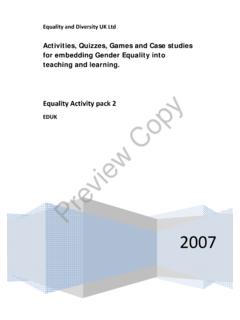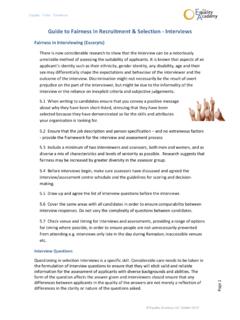Transcription of CHANGING THE GENDER SITUATION IN FORESTRY
1 TIME FOR ACTION. CHANGING THE GENDER SITUATION IN FORESTRY . REPORT OF THE UNECE/FAO TEAM OF SPECIALISTS ON GENDER AND FORESTRY . i Time for action CHANGING the GENDER SITUATION in FORESTRY Report of the team of specialists on GENDER and FORESTRY FAO, 2006. )$2 6. iii FOREWORD. The Team of Specialists on GENDER and FORESTRY ' was established in April 2004 by a decision of the former FAO/ECE/ILO Joint Committee on Forest Technology, Management and Training. The objective was to raise visibility of women and women's involvement in the FORESTRY sector and to understand the GENDER structures throughout the sector. The Team's mandate was developed from discussions and recommendations at the FAO/ECE/ILO seminar in Viseu, Portugal in 2001, and has been regarded as part of a strategic framework for the work carried out by the Team during the two years period. The Team focussed on reviewing relevant and available data, which is compiled and presented in this Final Report. The Team was made up of 15 specialists from across Europe and North America, and the work has mainly been carried out by team members.
2 I would like to thank the Team for their contribution and goodwill, and for committing themselves on top of normal duties to execute the manadate given by the former joint committee. In particular, I thank the Team coordinators Anna Springfors and Simmon Rose, the editors Renate Sp eth, Marion Karman and Maria Gianinni and the lay-out artist Maria Guardia. In addition to Team members' work, very valuable contributions have been made by a number of other persons; Inna Hakobjanyan, Mike Fullerton, eljka Ivanovi , Marilena Id ojti , Katja Turunen, Ritva Toivonen, Laura Secco, Laura Peruch, Viera Petrasova, Zusana Sarvasova Lea Jylha, Diana Mizaraite, Uta Hohn, Andreas Keil, Orhan G les, Mulualem Tigabu, Robert Nyg rd, Margareta S derberg Maria Hehn and Till Westermayer. I would like to thank them all for their efforts which have enriched this Final Report. However, the work on this important subject is not nished, indeed scarcely begun. I hope that what we have done will not only raise awareness, but also lead to actions for a better GENDER balance in FORESTRY .
3 Gun Lidestav Team Leader v CONTENTS. FOREWORD iii Introduction 1. Background 1. 1 GENDER structures in FORESTRY organizations 7. Introduction 7. Review of the current SITUATION 8. What is the current status quo of GENDER representation across organizations? 8. Why is GENDER representation as it is? 12. What are the key drivers for change and the actions required in driving the employment GENDER agenda forward? 13. What are the positive bene ts to be gained? 15. 1. 3 Employment Trends The European Forest Sector Outlook Study 16. Armenia 17. Introduction: 17. Socio-demographic SITUATION in Armenia, including GENDER issues 17. GENDER structure in Armenian FORESTRY 18. Employment at other Armenian FORESTRY agencies 18. Conclusions 20. Canada 20. The Employment Equity Framework in Canada 20. GENDER -based analysis 21. GENDER issues in Natural Resources Canada and the Canadian forest service 22. GENDER statistics for the Canadian forest sector 24. GENDER demographics of Canadian university graduates 24.
4 Conclusion 25. 1. 6 Croatia 26. Summary 26. Introduction 27. Methodology 28. Results 28. Conclusions 29. Finland 29. Background 29. Data 30. Results 30. Activities to develop women foresters' careers in Finland 32. Conclusions 33. Germany 33. The current status of GENDER representations across organizations in Germany 34. Why is the GENDER representation the way it is in Germany's FORESTRY sector? 38. Italy 39. Introduction 40. Of cial data on women in the primary sector in Italy 40. Results of a preliminary ad hoc survey in Italy 47. Final considerations for Italy 49. Norway 50. General aspects of the FORESTRY sector in Norway 50. GENDER representation across organizations in Norway 50. GENDER structure within FORESTRY education 53. GENDER representation in Norway 55. What are the key drivers for CHANGING the GENDER agenda forward in Norway? 56. vi What are the positive bene ts Norway can gain? 57. Poland 58. Background 59. General characteristics of Poland's forests and FORESTRY 60.
5 GENDER in forest ownership 61. Employment in Poland and the FORESTRY sector 63. Women in science 65. Conclusion 65. Slovakia 66. Introduction 66. Women's SITUATION in Slovakia 66. Educational level of female foresters 67. Conclusion 68. Sweden 69. Swedish FORESTRY in general 69. The current status quo of GENDER representations across organizations in Sweden 69. Why is GENDER representation the way it is? 71. United Kingdom 73. Employment of women in UK FORESTRY industry 73. What are the reasons for this picture? 76. What can be done to address the imbalance? 78. The United States 79. The United States Forest Service Agency 79. The Forest Service administrative units 79. Workforce objectives 79. GENDER history 80. CLF comparisons with women in the Forest Service 80. Forest Service leadership positions 82. Leadership at national headquarters 82. Leadership across the United States 82. Women in key leadership positions 82. Review of GENDER SITUATION in other countries 83.
6 Summary 86. 2 GENDER structures in family FORESTRY 89. Introduction 89. Ownership structure in the ECE area 89. Lack of data 90. GENDER structures in Swedish family FORESTRY 90. Introduction 90. GENDER and inheritance in Swedish family FORESTRY 90. Comparing male and female owners 93. Women's representation in forest owners' associations 95. Nordrhein-Westfalen, Germany 96. Introduction 96. Survey concerning forest owners' structure and motivation 96. Conclusions 96. Norway 97. Introduction 97. GENDER structure in the Norwegian FORESTRY Association 97. GENDER structure in the Norwegian Forest Owners' Federation 98. GENDER structures in Finnish family FORESTRY 104. The Finnish ownership structure 104. The MTK 105. GENDER structure at the national level 105. The Regional level 105. vii MTK's equality programme 105. GENDER structures in Baltic family FORESTRY 106. General aspects of the FORESTRY sector in the Baltic States 106. Private management problems and the needs of the private forest owners 107.
7 Conclusions 109. Summary and conclusions 109. 3. GENDER and perceptions of forest and FORESTRY 111. Perceptions of forests and FORESTRY what people think about forests and FORESTRY 111. The public's perception of and relation to the forest or how Swedish men and women view the forest 113. Innovation and FORESTRY : Attracting visitors and CHANGING perceptions 115. Borders Forest Trust Projects: 116. The importance of initiatives like BFT in the United Kingdom 118. Future Research on CHANGING perceptions about FORESTRY 118. Urban nature perception, evaluation and adoption by Turkish migrants in the northern Ruhr area under special consideration of urban-industrial woodlands 119. Research design 119. Interview of the residents 119. Expert interviews 120. Conclusion 120. Summary 122. 4. Means and actions 123. Introduction 123. Political tools 123. Sweden 123. Political tools in Norway 126. The United States Civilian Labor Force 128. The GENDER mainstreaming strategy within the European Union 128.
8 GENDER issues in education and research: cases and examples 134. Introduction 134. Do GENDER -related factors in uence students' choice of courses at the Faculty of Forest Sciences, SLU, Ume ? 135. GENDER issues in FORESTRY curricula results from surveys in 2002 and 2004 136. GENDER studies a new subject in FORESTRY curricula: the University of Freiburg, Germany 139. GENDER does matter: studying corporate culture and the possibilities for GENDER -sensitive reforms in Germany's forest services 144. Networks on women and FORESTRY 146. Networks in Sweden 147. Slovakia 148. Lithuanina 149. Networks in Germany 150. The Norwegian organization Women in FORESTRY 152. 5. Criteria and indicators 155. 6. Summary and conclusions 157. REFERENCES 163. ANNEXES 173. I. List of acronyms and de nitions: 173. II. List of Tables 174. III. List of Figures 176. IV. List of ToS members 177. V. Norway: Political tools 178. VI. Norway: Actions carried out by Women in FORESTRY 181. VII. References to endnotes for Questions 4 to 7 185.
9 Introduction 1. INTRODUCTION. BACKGROUND. Human societies are deeply pervaded by the principle of GENDER , by which individuals, animals and inanimate objects and things are sorted and assigned a value. Throughout history, most phenomena have been given a masculine or feminine connotation. Ideas of speci c masculine or feminine qualities are thus connected to certain roles, positions, tasks and professions in individuals. The perception of what is appropriate for men and women forms the basis for the distribution of work, the design and the evaluation of different tasks, and the criteria for promotions. FORESTRY is not an exception to this since it has been generally regarded as an arena mainly for men's work, business and governance. Within organizations, from households to companies to authorities, a gendered organizational logic is at work, which not only reproduces a structure of GENDER division but also, paradoxically, at the same time, makes GENDER invisible. GENDER invisibility comes in many forms.
10 One example is the way in which the terms FORESTRY and FORESTRY work are de ned and perceived, while another is the way statistics on the involvement of women and men in the FORESTRY sector are not kept separate, or not at all. In many countries, reliable statistics on the demographics of the FORESTRY workforce are dif cult to obtain, and when it concerns women's participation, data are virtually non-existent. Similarly, information on women's involvement in family FORESTRY , both as part of the workforce and as owners, is also scarce. Therefore, in April 2004, the Joint FAO/ECE/ILO Committee on Forest Technology, Management and Training established a Team of Specialists (ToS) to study GENDER and FORESTRY in order to raise visibility of women and women's involvement in the FORESTRY sector and to understand the GENDER structures throughout the sector. The ToS was an outcome of the seminar on Women in FORESTRY Strategies to Increase Women's Participation in the FORESTRY Sector in Europe and North America , which was held in Viseu, Portugal, in April 2001.

















